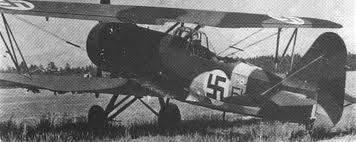|
|
Suomalaiset syöksypommittajat talvisodassa.Syöksypommitus talvisodassa rajoittui kahden Lentolaivue 10:n lentueen toimintaan, joiden miehistöt olivat saaneet syöksypommituskoulutuksen ennen talvisotaa. Niillä kummallakin oli sodan alussa 4 FK:ta eli Fokker C.X:tä kalustonaan. Laivueen kolmas lentue ei ollut syöksypommitusosasto. Yhteensä laivueella oli sodan syttyessä 13 FK:ta. Rintamalaivuilla oli sodan alussa kaikkiaan 29 FK:ta. Talvisodassa menetettiin yhteensä 8 FK:ta, joista 3 oli LLv 10:n koneita. Laivueen miehistötappiot olivat 4 sotalennoilla kadonnutta upseeria, kaksi ilmatorjuntatulessa kaatunutta upseeria, yksi ilmataistelussa haavoittunut upseeri sekä yksi sotalennolla kadonnut lentomestari. Se lensi talvisodassa 135 taistelulentoa, joista 122 oli syöksypommituslentoja. Lisäksi lennettiin 7 tiedustelu- ja pommituslentoa sekä 6 tiedustelulentoa. Yhteensä LLv 10 pudotti talvisodassa lähes 27 tn pommeja.
Vaikka Fokker C.X oli aika hidas, sen huippunopeus oli 356 km/t 4000m:ssä, se oli vankkarakenteinen, sen suurin syöksynopeus oli 540 km/t, minkä avulla se pystyi irtautumaan neuvostoliittolaisista I-153 ja I-16 hävittäjistä, jos korkeutta oli lähtötilanteessa riittävästi. Koneen voimalähteenä oli yksi 830hv Bristol Pegasus XXI 9-sylinterinen tähtimoottori. Ohjaajan käytössä oli kaksi kiinteää tahditettua 7,7mm:n konekivääriä ja tähystäjällä yksi liikkuva kotimainen 7,62mm:n L-33/34 konekivääri. Alasiivessä oli pommiripustimet 200 - 400 kg:n kuormalle. Talvisodassa LLv 10 käytti enintään 300kg:n pommikuormaan, yleisin kuorma taisi olla 2x100kg+8x12,5kg pommia, myös esim. 2x50kg+ 8x25kg = 300kg, 2x50kg+7x25kg = 275kg, 2x50kg+6x25kg = 250kg pommikuormia käytettiin. Pienin LLv 10:n käyttämä pommikuorma, johon olen törmännyt, oli 2x50kg+6x12,5kg pommia eli 175kg:n pommikuorma. Lähteet: Lentolaivue 10:n sotapäiväkirja. Seeve, Olavi: ILMAPUOLUSTUS Suomen-Neuvostoliiton sodassa 1939 - 1940. Ilmavoimien Esikunnan YE-osaston operatiivinen toimisto (1941). Alunperin teoksesta tehtiin vain 5 kopiota. Heinonen, Timo: Thulinista Hornetiin. 75 vuotta Suomen ilmavoimien lentokoneita. Keski-Suomen Ilmailumuseon julkaisuja 3. Jyväskylä 1992, ISBN 951-95688-2-4. IN ENGLISH The Fokker C.X was a Dutch two-seat reconnaissance aircraft and dive bomber. Finland ordered four aircraft and purchased a manufacturing license in 1936. The C.X was the most important short-range reconnaissance aircraft of the Finnish Air Force at the outbreak of the Winter War. There were 29 of them in combat units, 8 of them in the two flights of Lentolaivue (LLv) 10, which were trained for dive-bombing. The third flight of the squadron wasn't dive-bombing capable. During the war, Fokkers of LLv 10 flew 135 combat sorties, of which 122 were dive-bombing sorties. Other war sorties were 7 reconnaissance and bombing sorties and 6 reconnaissance sorties. Altogether LLv 10 dropped almost 27 metric tons of bombs during the Winter War. In the early stages of the war, the "Frans-Kalle", slow but possessing a robust airframe, was a useful asset. As the hostilities continued, losses began to mount. During the Winter War 8 FKs were lost, 3 of which were planes of LLv 10. The human losses of the squadron during the Winter War were: Officers: 4 MIA, 2 KIA (AA-fire) and 1 WIA(air combat) NCOs: 1 MIA Warrant Officer The Fokker C.X had a wing span of 12 m, length 9.01 m, operating weight 2,700 kg, one 830hp Bristol Pegasus XXI 9 cylinder radial engine and maximum speed 356 km/h. Max bomb load was 400kg but during the Winter War the max bomb load used by LLv 10 was 300kg. Maybe the most common load was 2x100kg+8x12,5kg bombs = 300kg, also e.g. 2x50kg+8x25kg = 300kg, 2x50kg+7x25kg = 275kg, 2x50kg+6x25kg = 250kg loads were used. The lightest bomb load used by LLv 10 I have come across was 2x50kg+6x12,5kg = 175kg. Sources: Lentolaivue 10:n sotapäiväkirja. (The squadron ORB). Seeve, Olavi: ILMAPUOLUSTUS Suomen-Neuvostoliiton sodassa 1939 - 1940. Ilmavoimien Esikunnan YE-osaston operatiivinen toimisto (1941). (a secret study on the Finnish Air Force and the Finnish AA-artillery during the Winter War written at the HQ of the Finnish Air Force). Heinonen, Timo: Thulinista Hornetiin. 75 vuotta Suomen ilmavoimien lentokoneita. Keski-Suomen Ilmailumuseon julkaisuja 3. Jyväskylä 1992, ISBN 951-95688-2-4. |

